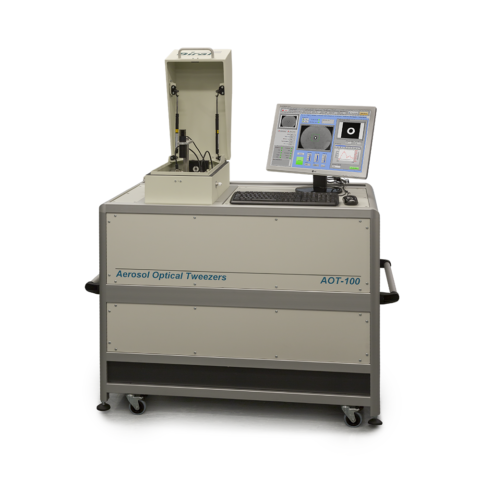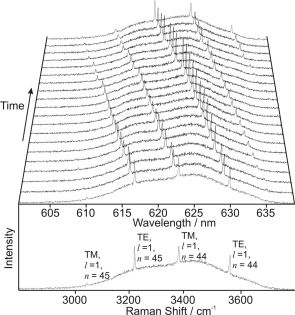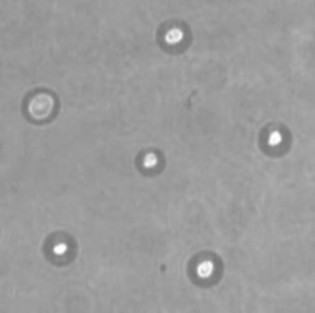Overview
The AOT-100 Aerosol Optical Tweezers allow users to hold airborne particles for extended periods with ease. Holding particles in an optical trap enables many different parameters to be studied continuously over times varying from milliseconds to hours.
The AOT-100 Aerosol Optical Tweezers is the result of collaboration between the Bristol University Aerosol Research Centre and Biral.
The Aerosol Optical Tweezers (AOT) offers a step-change in what can be achieved in the measurement of airborne particles.
Most single particle aerosol characterisation instruments make measurements on particles as they transit a measurement space. This provides a snapshot of the particle characteristics at the time of measurement but cannot follow changes to the particle characteristics over extended periods of time. While this enabled measurements to be made on very large numbers of particles it severely limits what can be measured and precludes the study of any time-dependent processes.
The AOT-100 is able to hold particles in an laser optical trap for as long as required and this enables measurements that would be impossible in a transit. Changes to the chemical and physical characteristics of the particle can be monitored with time and with changes to the environment in which it is being held.
The instrument is equipped with the means to continuously control and monitor the humidity of the gaseous medium in which the particle is suspended. This provides a means of studying, for example, the chemistry of cloud droplets or the changes that occur when particles are inhaled.
By trapping particles in the focus of a laser beam the dynamic processes that are vital to the understanding the relationship between particles and the medium in which they are suspended become feasible. Aerosols play a vital role in many processes and studying their evolution with time is vital to developing a detailed understanding of fields as diverse as climate change and drug delivery to the lungs.
Contact Biral for more information.
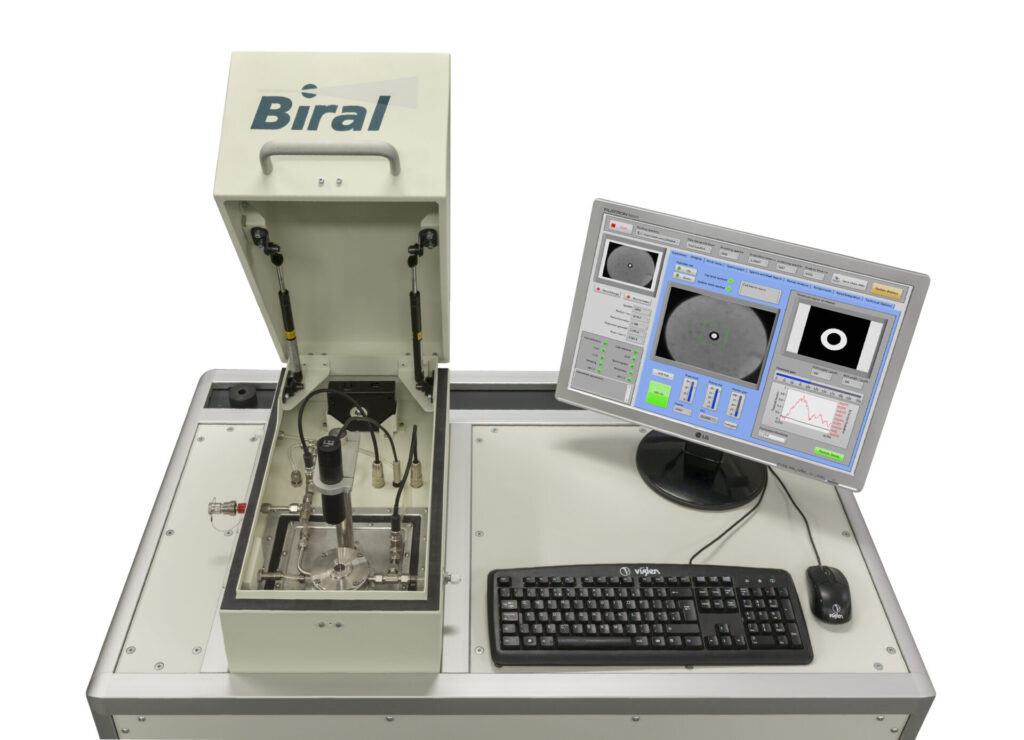
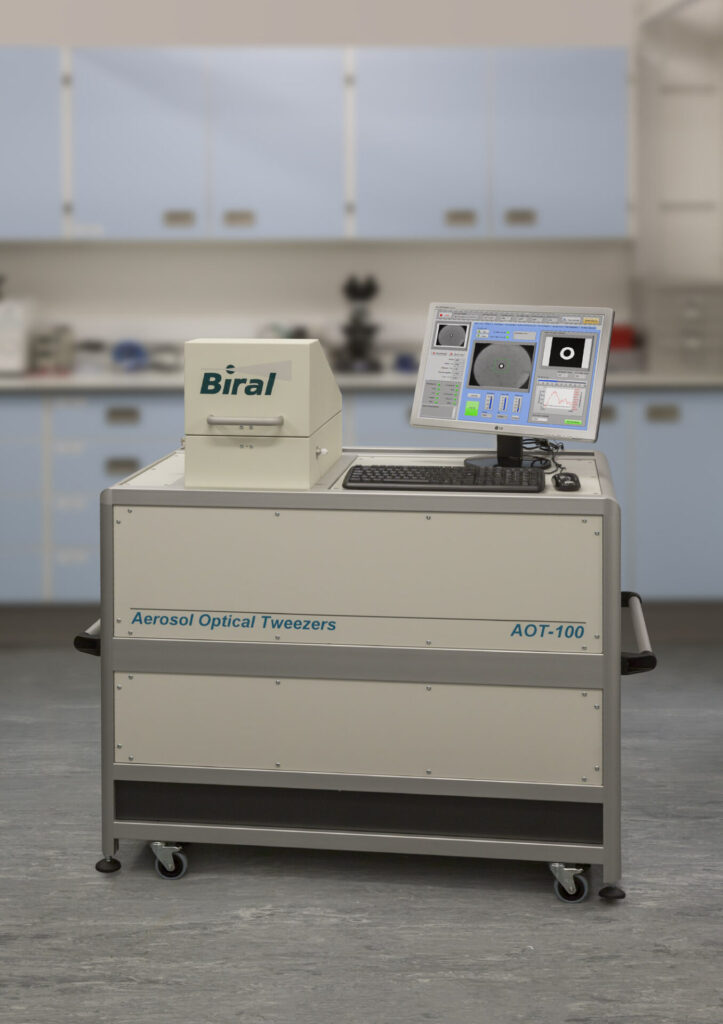
Features
The AOT-100
- The ability to trap multiple particles and move them within the cell by the use of a Spatial Light Modulator (SLM).
- A measurement cell that enables particles to be trapped and manipulated in a controlled environment.
- Precise measurement of particle size and refractive index.
- Single particle Ramen spectroscopy.
- Measurements can be made over periods ranging from milliseconds to hours or days.
- A 532nm trapping laser. Wavelength selected to minimise absorption by aqueous droplets.
- An optical system that creates a very tightly focussed beam and so a strong trap within the cell space.
- Particle illumination and imaging using a blue LED and a CMOS camera.
- A high resolution spectrograph and camera. This is primarily for Raman Spectroscopy but can be used for fluorescence where this is required.
- Humidity measurement and control of the gas in the measurement cell.
- The flow of reagent gases and vapours into the measurement cell.
- Easy removal of the measurement cell for cleaning.
- A fully optically safe working environment.
- Designed for use by those not expert in optical trapping techniques.
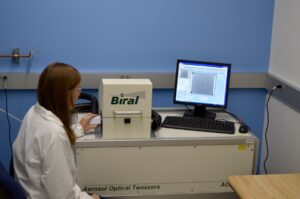
Technical Description
Instrument Design
The system is based on the research instrument designs developed by Professor Reid’s Aerosol Research Centre at the University of Bristol. The objective in developing the design of the AOT-100 has been to retain as many of the established principles as possible while making the instrument a readily usable tool that can be easily operated by non-specialists. The design has also made the instrument as compact as is achievable given the size of the constituent components and the optical path lengths required.
Particles are trapped within a measurement cell accessible through the cover on the top face of the instrument. The AOT-100 can be programmed to control the humidity within the cell over time allowing particle measurements to be taken in both static and dynamic conditions. The measurement cell also provides for the introduction of other gases allowing the measurement of particle properties in response to gaseous reagents.
The AOT-100 is designed to operate in a normal laboratory environment. The design takes care of all laser safety issues removing the need for local laser safety facilities and procedures whilst protecting the user. The AOT-100 is H1289 x L1356 x D720mm wide allowing its installation in most facilities.
Data Acquisition and Software
An on-board computer controls all components of the system as well as the acquisition and analysis of the data generated. The AOT-100 is supplied with a monitor and keyboard for local use however remote operation is possible across standard networks.
Interactive software enables the control of all system variables including the SLM holograms which control the relative movement of multiple trapped particles.
Live Raman analysis of particle spectra permits the rapid acquisition of very accurate particle size and refractive index measurements using the wavelengths of Whispering Gallery Modes (WGMs) in the stimulated Raman Spectra. WGMs greatly amplify the weak Raman signals where the excitation wavelength is constructively enhanced by the droplet diameter containing an exact integral wave number.
Whispering gallery mode progression with changing particle size
Potential Applications
The instrument enables the simultaneous and time resolved measurement of a very wide variety of parameters on single particles and so has potential applications in many fields of aerosol science. Examples of the measurements that can be made include:
- Particle size to a resolution of 1nm
- Changes in particle size with a time resolution of <1s
- Particle composition by Raman spectroscopy
- Particle refractive index
- Particle morphology
- Particle/vapour chemical reactions
- Particle/particle chemical reactions
- Some aspects of particle biochemistry
- Droplet viscosity
Particle Carousel
Specifications
Particle Measurements
Measurement Capabilities
General
Publications
General reviews on optical manipulation of aerosol
(1) Wills, J. B.; Knox, K. J.; Reid, J. P. Optical Control and Characterisation of Aerosol. Chem. Phys. Lett. 2009, 481, 153–165.
(2) Reid, J. P. Particle Levitation and Laboratory Scattering. J. Quant. Spectrosc. Radiat. Transf. 2009, 110, 1293–1306.
(3) Krieger, U. K.; Marcolli, C.; Reid, J. P. Exploring the Complexity of Aerosol Particle Properties and Processes Using Single Particle Techniques. Chem. Soc. Rev. 2012, 41, 6631–6662.
Optical manipulation of arrays of aerosol droplets in optical landscapes
(1) Butler, J. R.; Wills, J. B.; Mitchem, L.; Burnham, D. R.; McGloin, D.; Reid, J. P. Spectroscopic Characterisation and Manipulation of Arrays of Sub-Picolitre Aerosol Droplets. Lab Chip 2009, 9, 521–528.
(2) Wills, J. B.; Butler, J. R.; Palmer, J.; Reid, J. P. Using Optical Landscapes to Control, Direct and Isolate Aerosol Particles. Phys. Chem. Chem. Phys. 2009, 11, 8015–8020.
Measurements of droplet size and complex refractive index
(1) Preston, T. C.; Reid, J. P. Accurate and Efficient Determination of the Radius, Refractive Index and Dispersion of a Weakly Absorbing Spherical Particle Using Whispering Gallery Modes. J. Opt. Soc. Am. B 2013, 30, 2113–2122.
(2) Miles, R. E. H.; Walker, J. S.; Burnham, D. R.; Reid, J. P. Retrieval of the Complex Refractive Index of Aerosol Droplets from Optical Tweezers Measurements. Phys. Chem. Chem. Phys. 2012, 14, 3037–3047.
Measurements of droplet viscosity and surface tension
(1) Power, R. M.; Simpson, S. H.; Reid, J. P.; Hudson, A. J. The Transition from Liquid to Solid-Like Behaviour in Ultrahigh Viscosity Aerosol Particles. Chem. Sci. 2013, 4, 2597–2604.
(2) Power, R. M.; Reid, J. P. Probing the Micro-Rheological Properties of Aerosol Particles Using Optical Tweezers. Reports Prog. Phys. 2014, 77, 074601.
Investigations of aerosol particle interactions and coalescence
(1) Power, R. M.; Burnham, D. R.; Reid, J. P. Toward Optical-Tweezers-Based Force Microscopy for Airborne Microparticles. Appl. Opt. 2014, 53, 8522–8534.
(2) Power, R. M.; Reid, J. P.; Anand, S.; Mcgloin, D.; Almohammedi, A.; Mistry, N. S.; Hudson, A. J.; Almohamedi, A.; Downie, M. Observation of the Binary Coalescence and Equilibration of Micrometer-Sized Droplets of Aqueous Aerosol in a Single-Beam Gradient-Force Optical Trap. J. Phys. Chem. A 2012, 116, 8873−8884.
Measurements of water condensation and evaporation kinetics from aerosol droplets, including from glassy particles
(1) Miles, R. E. H.; Knox, K. J.; Reid, J. P.; Laurain, A. M. C.; Mitchem, L. Measurements of Mass and Heat Transfer at a Liquid Water Surface During Condensation or Evaporation of a Sub-Nanometre Thickness Layer of Water. Phys. Rev. Lett. 2010, 105, 116101.
(2) Bones, D. L.; Reid, J. P.; Lienhard, D. M.; Krieger, U. K. Comparing the Mechanism of Water Condensation and Evaporation in Glassy Aerosol. Proc. Natl. Acad. Sci. U. S. A. 2012, 109, 11613–11618.
Studies of phase separations in aerosol droplets and particle morphology
(1) Stewart, D.; Cai, C.; Nayler, J.; Preston, T. C.; Reid, J. P.; Krieger, U.; Marcolli, C.; Zhang, Y.-H. Liquid-Liquid Phase Separation in Mixed Organic/Inorganic Single Aqueous Aerosol Droplets. J. Phys. Chem. A 2015, 119, 4177–4190.
(2) Reid, J. P.; Dennis-Smither, B. J.; Kwamena, N.-O. A.; Miles, R. E. H.; Hanford, K. L.; Homer, C. J. The Morphology of Aerosol Particles Consisting of Hydrophobic and Hydrophilic Phases: Hydrocarbons, Alcohols and Fatty Acids as the Hydrophobic Component. Phys. Chem. Chem. Phys. 2011, 13, 15559–15572.
Studies of heterogeneous aerosol chemistry
(1) Dennis-Smither, B. J.; Miles, R. E. H.; Reid, J. P. Oxidative Aging of Mixed Oleic Acid/sodium Chloride Aerosol Particles. J. Geophys. Res. 2012, 117, D20204.
(2) Dennis-Smither, B. J.; Marshall, F. H.; Miles, R. E. H.; Preston, T. C.; Reid, J. P. Volatility and Oxidative Aging of Aqueous Maleic Acid Aerosol Droplets and the Dependence on Relative Humidity. J. Phys. Chem. A 2014, 118, 5680–5691.
Determination of component vapour pressures and hygroscopic growth
(1) Cai, C.; Stewart, D. J.; Preston, T. C.; Walker, J. S.; Zhang, Y.-H.; Reid, J. P. A New Approach to Determine Vapour Pressures and Hygroscopicities of Aqueous Aerosols Containing Semi-Volatile Organic Compounds. Phys. Chem. Chem. Phys. 2014, 16, 3162–3172.
(2) Cai, C.; Stewart, D. J.; Reid, J. P.; Zhang, Y.; Ohm, P.; Dutcher, C. S.; Clegg, S. L. Organic Component Vapor Pressures and Hygroscopicities of Aqueous Aerosol Measured by Optical Tweezers. J. Phys. Chem. A 2015, 119, 704–718.
Studies of aerosol used in drug delivery to the lungs
(1) Haddrell, A. E.; Davies, J. F.; Miles, R. E. H.; Reid, J. P.; Dailey, L. A.; Murnane, D. Dynamics of Aerosol Size during Inhalation: Hygroscopic Growth of Commercial Nebulizer Formulations. Int. J. Pharm. 2014, 463, 50–61.
(2) Haddrell, A. E.; Hargreaves, G.; Davies, J. F.; Reid, J. P. Control over Hygroscopic Growth of Saline Aqueous Aerosol Using Pluronic Polymer Additives. Int. J. Pharm. 2013, 443, 183–192.
Downloads
Sales & Support
Contact Biral for more information
To find out more about this instrument or to discuss your application requirements please do not hesitate to contact Biral.
- Complete our enquiry form
- Email enquiries@biral.com
- Telephone +44 (0)1275 847787
After Sales Support
Biral offers free advice and technical support for the lifetime of the instruments we sell. Once you have purchased the unit you can always contact us for help using the links on our Service Support page.
Enquire about this product
"*" indicates required fields
